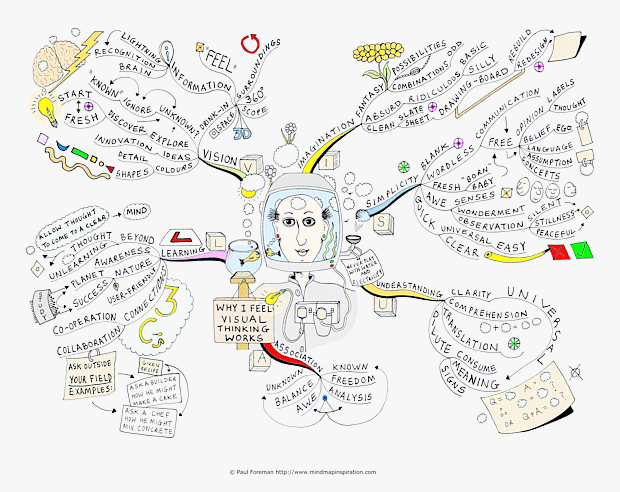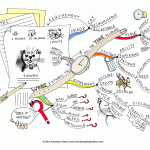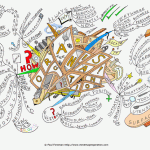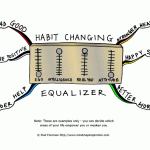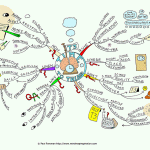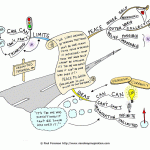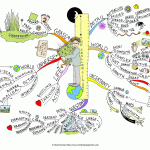I feel Visual Thinking works well because it can be used without language; often without the need of labels or written instructions, like universal signs that everyone recognises.
Each time we move, our brain helps us observe our surroundings instantly. Wherever you are you tend to assess the surroundings with very little analysis, quickly seeing colours, shapes, sizes, textures and the safety of your immediate environment. When you walk downstairs for example you are not labelling every single item en route, each object is acknowledged in a flash and you move through the environment to get where you wish to go. Your brain is drinking in the information and makes instant observations and decisions; recognising images at lightning fast speeds. I feel this is a crucial point – we don’t see everything with a written label on it or need a complete essay unless we make a conscious decision to stop and analyse each object in greater detail.
The brain is an incredible computer capable of thinking of and identifying many images or objects simultaneously and ultra fast.
Associations
A quick example; seeing, hearing or thinking the name “Clint Eastwood” I instantly have a picture in my mind. If I then consider words and associations, I may think of: a man in a cowboy hat with stubble smoking a cigar and squinting his eyes. I might then add more detail such as westerns, cowboys, horses, Malpaso films, director, producer, actor, tall, good-looking, hundreds of roles, famous, spurs – even though I know very little about Clint Eastwood I have a picture and some associations in my mind. They may not all be accurate, or presented in order, yet now my mind knows (or thinks it knows!) about Clint Eastwood. All this started from an instant visual picture in my mind on hearing the name.
I wonder what the similarities might be here – say a huge number of people were asked to list the words that come to mind for a specific phrase and the words were compared? Could be an interesting experiment.
We make lots of assumptions about the “known”. That’s why I feel a lot of innovation comes from forgetting the known and looking at creating the unknown. It can be tricky to do this if you know your subject thoroughly and that is why I feel collaboration with others outside of your field provides new insights.
Visual exercise
If you use your imagination, you can come up with many seemingly absurd combinations and connections – imagine walking the same journey downstairs and labelling everything you see with a name other than what it is. If you try it you may unearth some incredible ideas; perhaps create a walking internal commentary and purposely name everything something else; for example the carpet could be sawdust. Pictures on the wall might be cabbages growing. So now we have the unlikely combinations of “sawdust and cabbages” and expanding the idea further; “sawdust carpets” “cabbage walls” “cabbage carpets” etc. Another wacky idea when eating a burger call it something else – “I am eating an aardvark and lettuce baguette” Why not? You might invent something! You might also improve the taste of the burger you are eating!
Seeing anew
Visual thinking reminds me of how a baby views the world. They look fascinated by their surroundings. Without any learned concepts or vocabulary they watch in awe and drink in their surroundings without labels. If they could speak they would probably be saying “wow” a lot! Without words, I feel they are having a peaceful experience and understanding on a different level – with little or no need of thought. After all – can they think without having learnt words? I think the visual element gets covered up to a degree as we grow older and start learning “stuff” and applying “labels”. As we age we tend to start “seeing” with our minds based on our individual learning rather than actually seeing anew or seeing what is. It’s tricky thinking without known concepts try thinking back now to how you might feel putting your hand in cold water for the first time with no knowledge of what it is!
Simple recognition
Visual thinking is often simple – like quick universal signs everyone recognises. I feel the brain looks for simplicity to understand – so even when confronted with big words and complex concepts it really seeks simplicity, clarification and understanding – like translating or diluting into meaning. We keep asking questions until we understand. Naturally the more complicated something becomes the more it is open to different interpretations and levels of understanding, so the dilution can either become wrong or at least different to what others interpret.
Could it be simpler?
We have hundreds of thousands of words – spoilt for choice! What if there were more letters in the alphabet? More words – would it result in more confusion? Probably!
What if there were less words? What if we simplified our language? What if we began to look at alternative ways to communicate other than words. What if we look beyond words, beyond thought, to nature, to the potential of our imaginations? What if instead of adding more confusion we create a simple vocabulary? Perhaps dilute our language? Maybe create one simple universal language for the planet. I wonder if it might create greater understanding. I’m sure it could improve communication. Imagine removing all negative words and honing in on positivity. Imagine a solely visual language.
Fast build
Clear and simple instructions are far better than ambiguous details – think of constructing home-assembly furniture: sometimes the instructions are brilliantly clear other times totally useless! Often it is easier to start building without looking! Occasionally you see instructions in images and arrows and they can sometimes be easier to follow than words. Simplicity for me is about making things user-friendly; creating a smooth path to the intended goal. Visual thinking I feel helps encourage simplicity and makes life easier. I feel it brings us home to awe and excitement, to a love of learning and to a world of fascination and less confusion.
If you create products, for example, I feel that by utilising simplicity you open your market out to a whole new audience. In our modern day living environment, people like quick, fast and easy to understand; straight to the point: people want convenience and solutions. Simple products are easy to understand, so I feel simple sells and simple wins; same with ideas and concepts. Here is a question to ponder: “How could I make what I do so simple it would be impossible to fail when using it?”
Sharing knowledge & ideas
I think we could also make better use of collaboration across niche sectors. It may uncover fresh ideas and new ways of thinking; the more odd the connections the better to help nurture fresh thinking.
Getting caught up in analysis and the known can prevent us reaching new solutions or alternative ways of working. Stuck in problems rather than transcending them. I feel that as we learn, to a degree we move from awe to analysis. I’d like to see a move away from thinking we know. More collaboration for joint success; perhaps working with competitors rather than always trying to out do them. Start anew – revisit old themes and design and invent the future as we would like to see it. Work backwards from optimum vision to drawing board concept.
Rediscovery
What if we could rediscover the already discovered?
Imagine mixing and blending what the planet produces, like a painter creating new tints. There might be a combination that surprises us! Could there be a new formula from the already known? Using combinations, exploring and asking questions, might we discover that the planet has more to offer us than we thought? Mix a pineapple, two coconuts and six potatoes and we could have a new substance that cures baldness! Who knows what the possibilities might be! Imagine the fun in experimentation – the awe of discovery open to all of us.
I’d like to see a journey back from analysis to the awe of the unknown.
The whole World was once entirely new to you – could it be new again?
More from Mind Map Inspiration:
Submit your review | |

